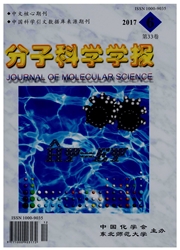

 中文摘要:
中文摘要:
应用密度泛函理论的MPW1K,BHandHLYP和MPWB1K方法,结合6-31+G(d,p)基组优化了烯丙醇与臭氧反应势能面上各驻点的几何构型,通过同一水平的振动频率分析确认了中间体和过渡态.反应路径上的驻点都在HL理论水平下进行单点能量校正,并进行了MPW1K/6-31+G(d,p)水平下的零点振动能校正(ZPE).对反应机理的详尽分析表明臭氧抽取烯丙醇羟基基团中H的通道的反应势垒比臭氧加合烯丙醇双键基团通道的反应势垒高,臭氧与烯丙醇双键加合生成臭氧化物为最可几反应路径.在加合反应历程中,氢迁移通道需经过氢迁移和离解等复杂过程,最终要产生少量的OH自由基,与烃烯类臭氧化反应产生大量OH自由基的结果相反.
 英文摘要:
英文摘要:
MPW1K/6-31+G(d,p),BHandHLYP/6-31+G(d,p),and MPWB1K/6-31+G(d,p) levels of theory are employed to optimize the geometries of stationary points for the mechanisms of gas-phase ozonolysis of Allyl alcohol.The single-point energy calculations are refined at the HL level of theory based on the MPW1K-optimized geometries.The frequencies at the MPW1K level of theory are used to evaluate ZPVE corrections to the single-point energies.Two different reactive sites of allyl alcohol,C=C and OH groups have been investigated,and results confirm that the C=C group is a highly reactive site.The calculated mechanisms indicate that in ozone-allyl alcohol reaction the yields of OH might be trivial,which is different from the reactions of ozone with unsaturated hydrocarbons.
 同期刊论文项目
同期刊论文项目
 同项目期刊论文
同项目期刊论文
 Geometries, stability and aromaticity of Al2P22(, [M(Al2P2)]((M=Li, Na, K, Cu) and N(Al2P2) (N=Be, M
Geometries, stability and aromaticity of Al2P22(, [M(Al2P2)]((M=Li, Na, K, Cu) and N(Al2P2) (N=Be, M Structures and aromaticity of the planar B2XY (X = N, P and Y = O, S, Se)
and Al2MN (M = C, Si, Ge a
Structures and aromaticity of the planar B2XY (X = N, P and Y = O, S, Se)
and Al2MN (M = C, Si, Ge a 期刊信息
期刊信息
